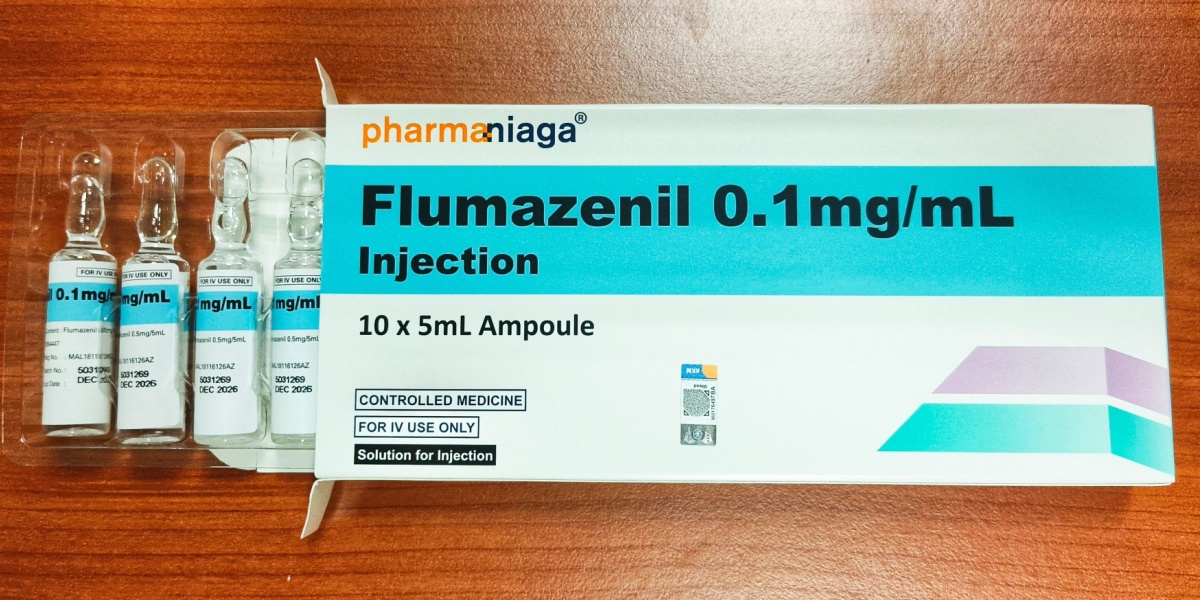Benzodiazepines are one of the most commonly prescribed drugs in the United States, with approximately 30.6 million adults using them yearly, and 5.3 million of those individuals becoming dependent or abusing the drug. [1]
Because of their strong sedative effects, reversal agents like flumazenil have become crucial in the treatment of both acute overdoses and benzodiazepine dependence. [2] Although flumazenil has been shown to have a higher incidence of serious adverse events when used for acute overdose, recent research has demonstrated its vital use in benzodiazepine withdrawal.
Below, we will explore how flumazenil works, how it is used in substance use disorder treatment, and important safety, administration, and dosage guidelines.
- Flumazenil, a GABA antagonist, can help manage benzodiazepine withdrawal by reducing symptoms and cravings.
- It is primarily used for benzodiazepine overdose reversal but has shown potential for dependence treatment.
- Safety concerns and limited availability make its use in long-term benzodiazepine recovery challenging.

Understanding Flumazenil
Flumazenil is a competitive antagonist of the gamma-aminobutyric acid (GABA) receptor. Flumazenil essentially has the opposite effect of benzodiazepine medications. Benzodiazepines enhance GABAergic activity and induce sedation, while flumazenil binds to the benzodiazepine receptor site without activating it, effectively blocking or reversing benzodiazepine effects. [2]
It is FDA-approved for the reversal of the effects of benzodiazepines that may occur as the result of benzodiazepine overdose or postoperative sedation from benzodiazepine anesthetics. The drug is also used off-label for the treatment of alcohol withdrawal syndrome, baclofen reversal, idiopathic recurrent stupor, cannabis toxicity, hepatic encephalopathy, and benzodiazepine detoxification or withdrawal. [2] In recent years its role in benzodiazepine withdrawal management has gained increasing interest.
Clinical applications in substance use disorder treatment
Although flumazenil is most often used to counteract benzodiazepine overdose, research has explored its potential in treating benzodiazepine dependence. Because of its ability to modulate GABA activity in the brain, researchers have explored its effects on reducing withdrawal symptoms and long-term dependence reduction.
Interestingly, flumazenil has also shown promise in treating other substance use-related conditions such as alcohol withdrawal and cannabis toxicity. [2]
Reversal of benzodiazepine overdose
The primary and FDA-approved use of flumazenil is in the emergency treatment of benzodiazepine overdose. By blocking GABA activity in the brain, it can counteract the effects of benzodiazepines that could potentially be fatal in an overdose, particularly respiratory depression. [2]
A 2015 study highlighted its efficacy when administered intravenously (in the vein) in reversing sedation and respiratory depression in overdose cases. [3] Flumazenil is characterized by a short half-life (0.8–1.2 hours) and requires repeated doses or continuous infusion to reverse benzodiazepine overdose. [4]
Unfortunately, based on other research, its use is limited by the risk of precipitating seizures, especially in individuals with multiple drug intoxication or chronic benzodiazepine use. [5]
Benzodiazepine withdrawal management
According to recent research, flumazenil has shown promise as a potential treatment for benzodiazepine withdrawal. The common management of benzodiazepine withdrawal syndrome includes gradual tapering, switching to an equivalent dose of a long half-life benzodiazepine before tapering or adding medications prior to detoxification.
Flumazenil offers an alternative approach through rapid detoxification. When compared to placebo, bolus infusion of flumazenil (1 mg in 5 min) produced effects similar to benzodiazepine withdrawal, but multiple slow bolus infusions can reduce withdrawal symptoms more effectively. [4]
The subcutaneous route of administration (provided under the skin) has also been explored for flumazenil therapy. According to a 2021 study, continuous subcutaneous flumazenil infusion significantly reduced withdrawal symptoms compared to placebo. It also demonstrated improved patient compliance and reduced cravings with no reported adverse effects. [5] Potentially more importantly, researchers found serum levels of benzodiazepines were eliminated after 4 days of flumazenil administration, proving its efficacy in benzodiazepine detoxification. [5]
Studies have also investigated the role of flumazenil in resetting the GABAergic system, which may contribute to its effectiveness in long-term benzodiazepine discontinuation. Continuous low-dose infusions have been shown to cause improvements in psychological distress and reduced withdrawal severity, suggesting a potential neuroadaptive mechanism in benzodiazepine dependence treatment. [3]
Efficacy and safety considerations
Although flumazenil has been proven effective in rapidly reversing benzodiazepine overdose, there are considerable risks and limitations associated with this method of use.
For dependent individuals, it can precipitate withdrawal symptoms, and its short half-life also may require continuous infusion for sustained effects. [2][6]
Other risks associated with rapid administration of flumazenil include:
- Sedation
- Seizure
- Shortness of breath or difficulty breathing
- Cardiac arrhythmias
- Slow or rapid heart rate
- High blood pressure
- Chest pain
- Confusion or somnolence
- Dizziness, shivering, or headache
- Impaired cognition
- Nausea and/or vomiting
- Injection site reaction or pain
- Double or blurred vision
- Transient hearing impairment
- Anxiety, psychotic disorder, agitation, or panic attack [2]
Emerging evidence suggests that Flumazenil is both effective and well-tolerated in benzodiazepine detoxification when administered via subcutaneous infusion or slow continuous IV infusion.[5] Studies have demonstrated that subcutaneous flumazenil is not only safe but may provide more stable serum concentrations, reducing the likelihood of severe withdrawal symptoms or complications associated with abrupt benzodiazepine discontinuation.[5]
If you are considering treatment with flumazenil for benzodiazepine dependence, it is important to discuss the available treatment options and their appropriateness for you with your doctor.
Flumazenil vs. Other treatment options
The gradual tapering or slow lowering of the dosage of the benzodiazepines over some time remains the standard approach to benzodiazepine discontinuation. Researchers have found that gradual withdrawal over at least 10 weeks is typically successful in achieving long-term abstinence from benzodiazepines.[7]
Tapering puts individuals at risk of developing withdrawal symptoms, of particular concern is the risk of seizures. Medications like carbamazepine are moderately effective at reducing these risks.[8]
Flumazenil has been shown to accelerate withdrawal resolution. Compared to traditional benzodiazepine tapering methods, Flumazenil offers a unique mechanism of action that may lower long-term benzodiazepine dependence by modulating GABAergic function. It also can reduce uncomfortable withdrawal symptoms, which often lead to relapse for many individuals.
Medications like gabapentin and pregabalin are also being explored as alternatives to benzodiazepines for withdrawal management and may have fewer risks than flumazenil. [3]
Flumazenil administration and dosage guidelines
Flumazenil is usually given through an IV (intravenous) line. For overdose reversal, doctors start with a small 0.2 mg dose and add more as needed. If the patient isn’t waking up after 30 seconds, another 0.3 mg can be given, followed by additional 0.5 mg doses every minute until the total reaches 3 mg. If the person only partially responds, the dose can go up to 5 mg. If there’s no response after 5 mg, the sedation is likely not caused by benzodiazepines. If sedation returns, repeat doses can be given every 20 minutes but should not exceed 1 mg per dose or 3 mg per hour.[2]
For benzodiazepine withdrawal management, research suggests that a slow, continuous infusion of Flumazenil is more effective at easing symptoms without severe side effects.[4] Some studies also support using small, continuous doses delivered under the skin with an elastomeric pump, which may provide a safer, more controlled detox process than IV administration. [4]
Current limitations
Despite promising research, flumazenil’s role in benzodiazepine dependence treatment remains controversial. Its potential to induce acute withdrawal and seizures limits its clinical use.
Logistical challenges, such as the need for intravenous or subcutaneous administration and high costs, hinder its widespread adoption.[2] More research is needed to refine its protocols and determine its long-term efficacy and safety in treating benzodiazepine dependence.
Final thoughts
For individuals struggling with benzodiazepine dependence, Flumazenil may offer a potential path to recovery by easing withdrawal symptoms and reducing cravings. However, it is not without risks, and its use should be carefully considered under medical supervision.
As research evolves, patients and healthcare providers should stay informed about new findings that could improve flumazenil's safety and effectiveness in detoxification and long-term recovery.


-guide-detail.jpg?v=1722501796)